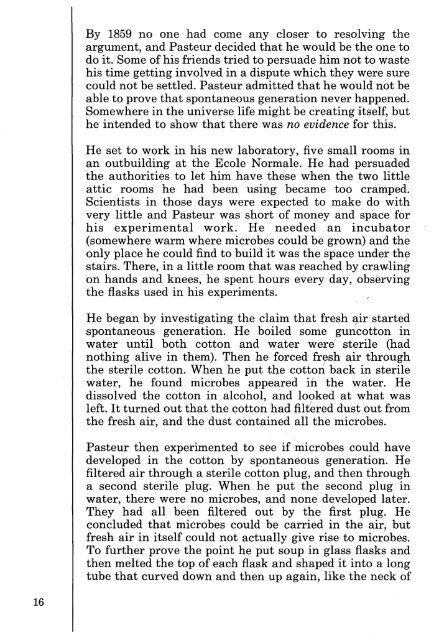Louis Pasteur by Nicola Kingsley - National STEM Centre
Louis Pasteur by Nicola Kingsley - National STEM Centre
Louis Pasteur by Nicola Kingsley - National STEM Centre
You also want an ePaper? Increase the reach of your titles
YUMPU automatically turns print PDFs into web optimized ePapers that Google loves.
16<br />
By 1859 no one had come any closer to resolving the<br />
argument, and <strong>Pasteur</strong> decided that he would be the one to<br />
do it. Some of his friends tried to persuade him not to waste<br />
his time getting involved in a dispute which they were sure<br />
could not be settled. <strong>Pasteur</strong> admitted that he would not be<br />
able to prove that spontaneous generation never happened.<br />
Somewhere in the universe life might be creating itself, but<br />
he intended to show that there was no evidence for this.<br />
He set·to work in his new laboratory, five small rooms in<br />
an outbuilding at the Ecole Normale. He had persuaded<br />
the authorities to let him have these when the two little<br />
attic rooms he had been using became too cramped.<br />
Scientists in those days were expected to make do with<br />
very little and <strong>Pasteur</strong> was short of money and space for<br />
his experimental work. He needed an incubator<br />
(somewhere warm where microbes could be grown) and the<br />
only place he could find to build it was the space under the<br />
stairs. There, in a little room that was reached <strong>by</strong> crawling<br />
on hands and knees, he spent hours every day, observing<br />
the flasks used in his experiments.<br />
He began <strong>by</strong> investigating the claim that fresh ~ir started<br />
spontaneous generation. He boiled some guncotton in<br />
water until both cotton and water were sterile (had<br />
nothing alive in them). Then he forced fresh air through<br />
the sterile cotton. When he put the cottorl back in sterile<br />
water, he found microbes appeared in the water. He<br />
dissolved the cotton in alcohol, and looked at what was<br />
left. It turned out that the cotton had filtered dust out from<br />
the fresh air, and the dust contained all the microbes.<br />
<strong>Pasteur</strong> then experimented to see if'microbes could have<br />
developed in the cotton <strong>by</strong> spontaneous generation. He<br />
filtered air through a sterile cotton plug, and then through<br />
a second sterile plug. When he put the second plug in<br />
water, there were no microbes, and none developed later.<br />
They had all been filtered out <strong>by</strong> the first plug. He<br />
concluded that microbes could be carried in the air, but<br />
fresh air in itself could not actually give rise to microbes.<br />
To further prove the point he put soup in glass flasks and<br />
then melted the top of each flask and shaped it into a long<br />
tube that curved down and then up again, like the neck of

















